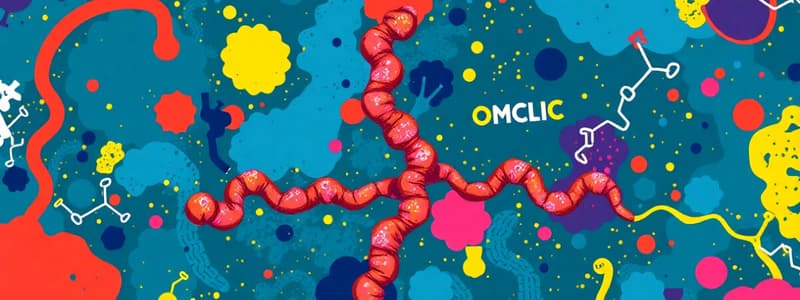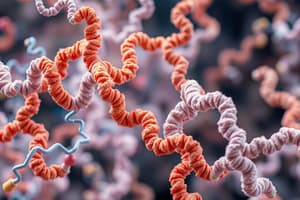Podcast
Questions and Answers
What is the primary role of proteins in the body?
What is the primary role of proteins in the body?
- Serving as a backup source of glucose
- Acting as essential building blocks for tissues and organs (correct)
- Regulating blood sugar levels
- Providing energy for immediate use
Which group of amino acids must be obtained through diet?
Which group of amino acids must be obtained through diet?
- Non-essential amino acids
- Synthetic amino acids
- Essential amino acids (correct)
- Conditionally essential amino acids
How many essential amino acids do cats require in their diet?
How many essential amino acids do cats require in their diet?
- 9
- 12
- 10
- 11 (correct)
Which amino acid is unique to cats and cannot be synthesized in their bodies?
Which amino acid is unique to cats and cannot be synthesized in their bodies?
What happens to surplus amino acids in the body?
What happens to surplus amino acids in the body?
Which of the following is NOT a component of protein function?
Which of the following is NOT a component of protein function?
What can be a consequence of feeding cats a diet high in plant products?
What can be a consequence of feeding cats a diet high in plant products?
Which animal has a total of 10 essential amino acids in its diet?
Which animal has a total of 10 essential amino acids in its diet?
What is one of the primary sources of nitrogen for the synthesis of nonessential amino acids?
What is one of the primary sources of nitrogen for the synthesis of nonessential amino acids?
What role do proteins play in muscles?
What role do proteins play in muscles?
What defines the biological value of a protein?
What defines the biological value of a protein?
What happens if there is excess protein in the body?
What happens if there is excess protein in the body?
Which factor does NOT significantly affect the quality of protein?
Which factor does NOT significantly affect the quality of protein?
Why are organ meats and animal byproducts included in pet diets?
Why are organ meats and animal byproducts included in pet diets?
Which of the following protein sources is considered a plant-based protein?
Which of the following protein sources is considered a plant-based protein?
What consequence can result from a deficiency of any essential amino acid (EAA)?
What consequence can result from a deficiency of any essential amino acid (EAA)?
Which protein quality term refers to the body's ability to convert absorbed amino acids for use?
Which protein quality term refers to the body's ability to convert absorbed amino acids for use?
Which protein source would have the higher digestibility generally?
Which protein source would have the higher digestibility generally?
How does fiber content influence protein quality?
How does fiber content influence protein quality?
What must occur for the body to store protein as fat?
What must occur for the body to store protein as fat?
Flashcards
Amino Acids
Amino Acids
The building blocks of proteins, these molecules link together in long chains to form complex structures.
Protein's role in the body
Protein's role in the body
Proteins are essential for building, repairing, and replacing tissues in the body.
Essential Amino Acids
Essential Amino Acids
These amino acids cannot be made by the body and must be obtained from the diet.
Non-Essential Amino Acids
Non-Essential Amino Acids
Signup and view all the flashcards
Protein Quality
Protein Quality
Signup and view all the flashcards
Taurine
Taurine
Signup and view all the flashcards
Taurine & Canned Food
Taurine & Canned Food
Signup and view all the flashcards
Protein Sources
Protein Sources
Signup and view all the flashcards
Protein Surplus
Protein Surplus
Signup and view all the flashcards
Protein & Enzymes
Protein & Enzymes
Signup and view all the flashcards
Biological Value
Biological Value
Signup and view all the flashcards
Essential Amino Acids (EAAs)
Essential Amino Acids (EAAs)
Signup and view all the flashcards
Protein Storage
Protein Storage
Signup and view all the flashcards
High-Quality Protein
High-Quality Protein
Signup and view all the flashcards
Low-Quality Protein
Low-Quality Protein
Signup and view all the flashcards
Digestibility of Protein
Digestibility of Protein
Signup and view all the flashcards
Protein Requirements
Protein Requirements
Signup and view all the flashcards
Animal Protein vs. Plant Protein
Animal Protein vs. Plant Protein
Signup and view all the flashcards
Organ Meats and Byproducts
Organ Meats and Byproducts
Signup and view all the flashcards
Cooking Effects on Protein
Cooking Effects on Protein
Signup and view all the flashcards
Study Notes
Protein Structure and Function
- Proteins are formed by amino acids linking together to create a complex 3D structure.
- Animals use 21 of the many amino acids to create proteins.
- Proteins are crucial for all bodily tissues and organs.
- Proteins are fundamental to cell structure, playing a role in cell walls.
- They're vital for tissue growth, repair, and maintenance.
- Dietary protein provides essential amino acids.
- Protein is crucial for synthesizing non-essential amino acids.
- Amino acids are essential for building, repairing, and replacing body proteins.
- Excess protein is converted to glycogen and potentially stored as fat.
Protein Functions in the Body
- Proteins are involved in many bodily functions, including:
- Providing structure to cartilage, tendons, and ligaments.
- Enabling muscle contraction.
- Forming skin, hair, and nails (keratin).
- Creating blood proteins (albumin, globulins, hemoglobin).
- Producing enzymes, hormones, and antibodies.
Essential, Non-Essential, and Conditionally Essential Amino Acids
- Amino acids are categorized into essential (must come from diet), non-essential (body can synthesize), and conditionally essential (needed in specific situations).
- Dogs require 10 essential amino acids, and cats require 11.
- Key essential amino acids for dogs: Arginine, Histidine, Isoleucine, Leucine, Lysine, Methionine, Phenylalanine, Threonine, Tryptophan, and Valine.
- Key essential amino acids for cats: Same as dogs plus Taurine.
Taurine
- Taurine is a conditionally essential amino acid critical for cats.
- It's not synthesized by cats and is vital for retinal function, and myocardial function.
- It's found predominantly in animal tissues.
- Diets high in plant-based proteins may not provide sufficient taurine in cats, particularly if the diet is largely dry food.
- Canned cat food often has a higher taurine requirement due to the heat-processing effect on protein.
Protein Quality and Source
- Protein quality varies based on the completeness and digestibility of the protein source.
- High-quality proteins provide essential amino acids in the correct proportions.
- Low-quality sources may lack sufficient quantities of specific amino acids.
- Cooking methods, temperature, and fiber content can affect the digestibility of protein sources.
- Animal-based proteins are generally considered higher quality.
Protein Deficiency Symptoms
- Deficiencies of essential amino acids can lead to:
- Impaired growth.
- Weight loss.
- Dull coat.
- Weakened immunity.
Protein Storage and Energy
- The body stores excess protein as dietary energy (fat) if caloric intake exceeds energy requirements.
Biological Value of Protein
- Biological value (BV) measures the body's ability to utilize absorbed protein.
- High BV proteins require less intake to meet amino acid needs.
Protein Sources in Diets
- Various animal and plant-based proteins are used: beef, chicken, pork, eggs, fish, various plant-based proteins (pea, potato, rice, soybeans).
- Organ meats and animal byproducts are common and contribute to sustainable practices by using otherwise wasted materials.
Protein Requirements
- Cats generally have higher protein requirements than dogs.
Studying That Suits You
Use AI to generate personalized quizzes and flashcards to suit your learning preferences.




